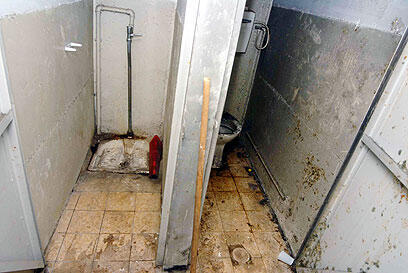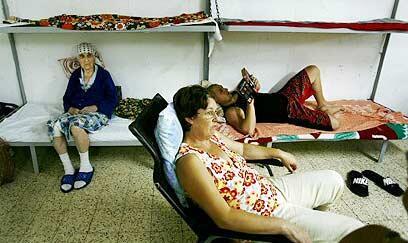The state comptroller and prime minister are bickering, the Home Front commander is busy petitioning the High Court of Justice, and Syria and Iran are rearming with missiles and rockets.
And in the meantime, Israel’s bomb shelters remain in a desperate state of neglect. Reports prepared by 80 local councils and attained by Ynet reveal the deplorable condition of shelters nationwide. Many lack suitable bathrooms and adequate ventilation systems. The situation is the worst in Arab communities, some of which lack shelters altogether.
Kiryat Shmona: Bathrooms in disastrous condition (Photo: Aviyahu Shapira)
Most of the authorities claim they lack the means to repair the shelters and look to the Home Front Command to improve the situation. The Home Front however shrugs off the responsibility claiming it is the job of the local councils and the Interior Ministry. The ministry, in turn, claims that budget funds were transferred in accordance with the recovery plans approved after the war in Lebanon.
In Safed, for example, there are 126 public shelters and 262 private shelters. The report drafted by the Safed municipality notes that the public shelters demand serious renovations, at an estimated cost of over NIS 7 million. As for the private shelters, the municipality says 112 were repaired by the Home Front Command, Amigor and the Livnot Ulehibanot (Build and be Rebuilt) fund, but 150 shelter remain in desperate need of repairs.
In Haifa there are 104 public shelters, most built in the 50s and 60s. According to the Operations Administration, “During the war in Lebanon, it became abundantly clear that the shelters were not fitting for long-term stays, and that they must be renovated and made suitable.” The cost was estimated at NIS 4.5 million.
As could be expected, the situation is the worst in Arab and Druze communities. Nazareth reported that it does not have even one public shelter in its territory. In villages that do have public shelters, most are located inside schools. The Alshajur council, which includes a number of villages that were hit hard by rocket barrages during the war, has no public shelters besides the ones at educational institutions. According to the report, seven of the 13 shelters need repairs.
Most shelters not suitable for long-term (Photo: Reuters)
The situation is no better in central Israel. In Bat Yam 27 public shelters need a full renovation, at an estimated NIS 1.8 million. Some have inadequate bathrooms and broken pumps. In Petah Tikva 25 public shelters demand repairs, and some are missing even the most basic amenities such as toilets and lighting.
Lacking funds
In consolidating data on the state of the shelters across Israel, the difficult state of affairs became abundantly clear to the Union of Local Authorities.
According to the law, the local authorities are responsible for maintenance of public shelters in their areas, which were built before protected areas were required in every home. However, chairman of the Union of Local Authorities Adi Eldar claims that most councils can’t subsidize maintenance, nevermind renovations.
“Even though it is their responsibility, most don’t have enough money. Even today, half a year after the war, no budget funds were transferred to the local councils to renew and reorganize public shelters," he said. However, the union noted that progress had been made regarding the allotment of funds.
Responses
The Interior Ministry issued a response saying, “The direct responsibility for maintaining public shelters is in the hands of the local authorities. The budget funds the Interior Ministry was meant to transfer to the authorities as part of the recovery plan were transferred in full. The Interior Ministry is aware of the importance, and in its last newsletter even published directions for maintaining shelters.”
The Prime Minister’s Office said that in September 2006 the Interior Ministry sent a letter to all local authority heads to clarify their civil defense obligations, including the maintenance of shelters.
“At the end of 2006, aid funds were budgeted for local councils in the North, and thus NIS 450 million was transferred to the authorities. An additional NIS 150 million were provided during the war. Part of the funds were intended for the renovation of shelters,” Olmert’s office declared.



